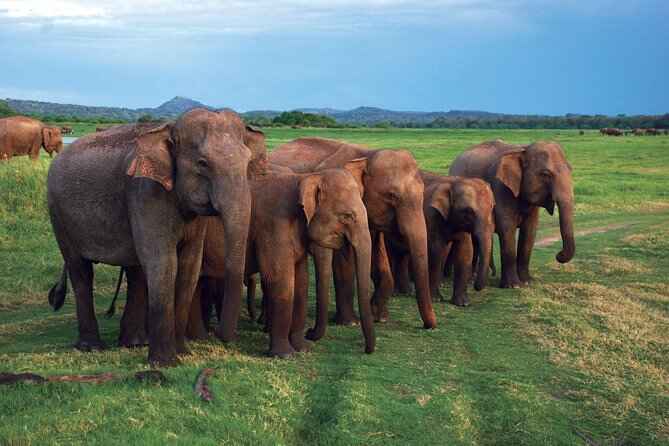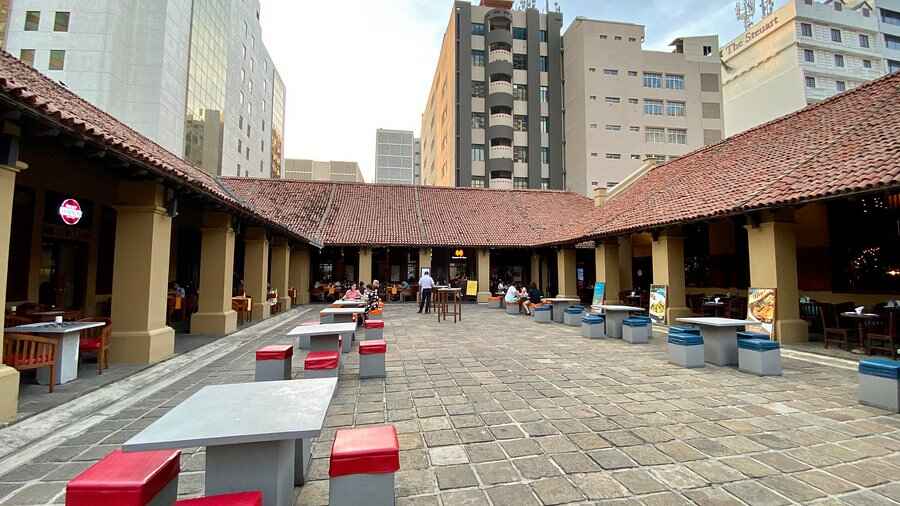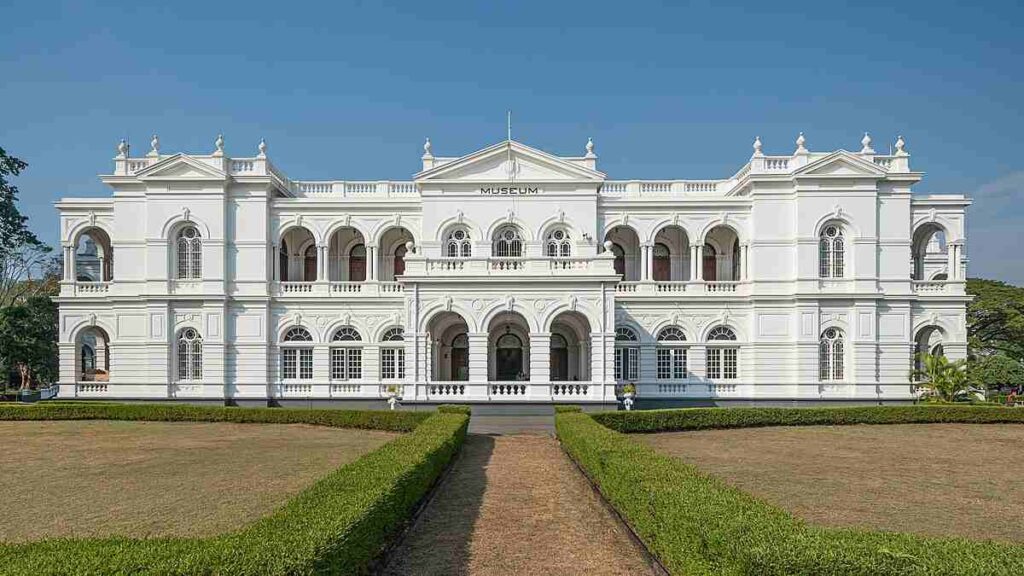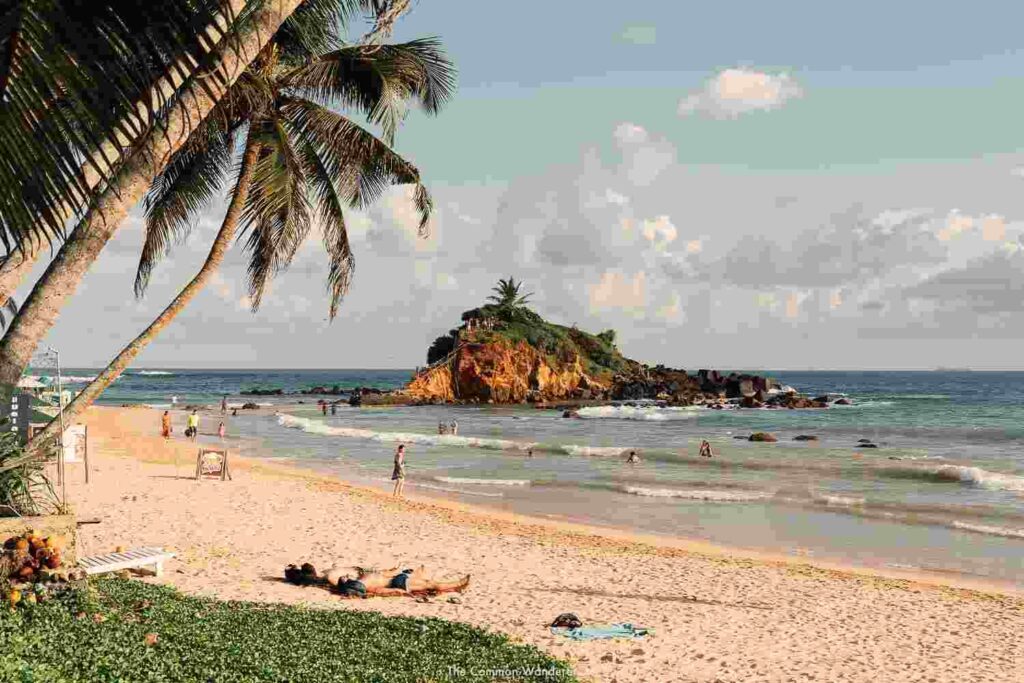Sri Lanka is simply irresistible with its endless beaches, ancient ruins, warm-hearted people, abundant elephants, rolling waves, affordable travel, scenic train rides, world-renowned tea, and rich, flavorful cuisine.

With its vast herds of elephants, wild buffalo, sambars, spotted deer, and giant squirrels, Uda Walawe National Park is one of Sri Lanka’s premier wildlife destinations. Often rivaling even East Africa’s famed reserves for elephant sightings, the park is centred around the expansive 308.2-sq-km Uda Walawe Reservoir. Its open, lightly vegetated terrain provides excellent visibility, making wildlife spotting particularly rewarding.
Home to approximately 600 elephants, often seen in herds of up to 50, the park also features an elephant-proof fence along much of its perimeter to minimize human-wildlife conflict. However, elephants do migrate through the unfenced areas. The best times to catch these gentle giants in action are between 6:30–10:00am and 4:00–6:30pm.
Beyond elephants, Uda Walawe shelters mongooses, jackals, crocodiles, water monitor lizards, sloth bears, and even the occasional leopard. Over 210 bird species have been recorded here, with migratory birds boosting numbers from November to April. Reptile lovers will also find around 30 types of snakes.
Safari Experience
Safaris typically begin at the park’s entrance, located 12km from the Ratnapura–Hambantota turn-off and 21km from Embilipitiya. Tickets (available until 5pm) include a knowledgeable park guide with a keen eye for wildlife. While many tours focus on elephants, you can request a broader experience that includes stops to enjoy birds, reptiles, and the park’s quieter residents. For a more peaceful outing, ask your driver to switch off the engine during stops and to avoid overcrowded sightings – ideally, no more than five vehicles should be present at one time.
4WD vehicles for half-day safaris usually cost around Rs 3500 for groups of up to eight. Tipping guides and drivers is customary.
Where to Stay
Spending a night near the park is ideal for early morning and evening safaris, which avoid the midday heat when most animals rest. While prices tend to be higher than coastal or highland stays, you’ll find good options such as Silent Bungalow, Superson Family Guest, and Elephant Safari Hotel. Though day tours operate from places like Ella, Tissa, and Ratnapura, staying nearby offers a far richer wildlife experience.

This 357-sq-km national park, formerly known as Yala East, offers a peaceful alternative to the often-crowded Yala National Park. Less touristy and more serene, it provides a more authentic wilderness experience. While wildlife density is lower, sightings of leopards, elephants, crocodiles, turtles, white cobras, wild buffalo, and numerous bird species are still possible. Although around a dozen sloth bears inhabit the park, spotting one is rare.
A highlight of the park is the Kumana Bird Reserve, a 200-hectare mangrove swamp located 22km beyond Okanda. Best visited between May and June during nesting season, it’s a paradise for birdwatchers. Sightings may include rare species like the black-necked stork as well as Malabar pied hornbills, green bee-eaters, painted storks, and blade-headed orioles. Even first-time birders can expect to see around 50 species in a single outing. Watchtowers scattered throughout the park provide excellent vantage points; binoculars and a field guide will greatly enhance the experience.
The main entrance lies near Okanda, about 22km southwest of Arugam Bay. Most visitors arrange jeep safaris through guesthouses in Arugam Bay—typically Rs 10,000 for a 3.5-hour tour including park fees. Morning safaris depart before dawn, while afternoon tours start around 2pm to catch the golden light and early signs of nocturnal activity.
Alternatively, you can hire a jeep at the park office near the gate. Entry includes a mandatory guide (usually a skilled wildlife spotter, though English may be limited). DIY arrangements can be slightly cheaper, but jeep availability may be uncertain during high or low season. In such cases, visitors can pass the time at small exhibits near the gate or do some birdwatching at the nearby lagoon hide while waiting for a vehicle.
Adult: US$10
Child: US$5
Vehicle hire: Rs 250
Group service fee: US$8
VAT: 8% on total
Tips for guides and drivers are customary for good service or sightings.

Once the gateway to Jaffna, the imposing Jaffna Fort stands watch over the lagoon, its weathered walls telling stories of centuries of conflict and change. Today, visitors can walk its ancient ramparts, explore crumbling barracks, and take in sweeping views of the city and sea.
Originally built by the Portuguese in 1619 during their conquest of the Jaffna Kingdom, the fort withstood multiple Sri Lankan uprisings over a 40-year period. In 1658, it fell to the Dutch, who later reinforced it with angular bastions, giving the fort its iconic pentagonal shape. The British took over peacefully in 1795 and held it until Sri Lanka gained independence.
During the civil war, the fort once again became a stronghold—used by government forces until it was seized by the LTTE after a brutal 107-day siege in 1990. Following the end of the war in 2009, efforts to restore the fort began, with support from the Dutch government. Restoration of its coral and stone structure is still ongoing today.
A visit to Jaffna Fort offers more than just historical intrigue—it’s a peaceful place to enjoy views of the Jaffna skyline and lagoon. Inside the main gate, a small exhibit details the fort’s archaeological and colonial past.
Entry fee: US$4 for adults, US$2 for children

This beautifully restored, terracotta-roofed building from the early 1600s is one of Colombo’s oldest colonial structures. Once a Dutch-era hospital, it now thrives as a stylish hub for boutique shopping, cafés, and fine dining. Its open central courtyard, lined with tiled eaves and stone benches, retains echoes of its past—where patients once rested under the stars.
Part of Colombo Fort, the site was originally established by the Portuguese in the 16th century. After a seven-month siege in 1656, the Dutch took control and built the hospital to serve employees of the Dutch East India Company, especially sailors arriving from long sea voyages. At the time, it was the largest hospital on the island. A canal once ran beside it, offering easy access from the port, though it was later filled in by the British.
Post-independence, the building saw various uses—including as an apothecary and police station—before its transformation into a heritage lifestyle precinct in 2011.
Today, the Dutch Hospital Shopping Precinct hosts a range of popular restaurants and bars:
Ministry of Crab – world-renowned for its fresh seafood
Heladiv Tea Club – a relaxing tea and dessert spot
T-Lounge by Dilmah – perfect for tea lovers
In the evenings, the courtyard often comes alive with live music, making it a favorite hangout for both locals and tourists.

Carved into a single granite rock face, Gal Vihara is one of Sri Lanka’s most iconic and revered sites, representing the pinnacle of ancient Sinhalese stone sculpture. Part of King Parakramabahu I’s northern monastery, this 12th-century complex showcases four distinct Buddha images, each once housed in its own shrine.
Reclining Buddha (14m): Depicts the Buddha entering parinirvana (nirvana after death). Look closely and you’ll notice intricate details like the soft dip in the pillow under the head and the lotus carvings on both the pillow and soles of the feet.
Standing Buddha (7m): Once thought to represent the grieving disciple Ananda due to its unusual crossed arms and sorrowful expression, this statue is now confirmed to be another portrayal of the Buddha. It is often considered the finest of the four.
Seated Buddha: Framed by an ornamental arch (torana) featuring four additional Buddhas, this image is believed to represent the Five Dhyani Buddhas, using the natural marbling of the granite to stunning effect.
Smaller Buddha: Housed in a niche to the side, this fourth image is less refined and smaller in scale, likely an earlier or unfinished work.
Together, these serene figures—still, silent, and monumental—reflect the spiritual and artistic zenith of Polonnaruwa’s golden age.

Housed in a grand neo-Baroque building dating back to 1877, Colombo’s National Museum is Sri Lanka’s premier cultural institution and a must-visit for anyone interested in the island’s history and identity. Founded by then-Governor William Henry Gregory, the museum offers a fascinating journey through Sri Lanka’s ancient kingdoms, colonial past, and cultural traditions.
Ancient Artefacts & Buddha Statues: Marvel at centuries-old statues, carvings, and artworks, with informative displays explaining the symbolism of Buddhist mudras and Sri Lanka’s artistic evolution.
Royal Treasures: Don’t miss the 1693 royal throne of King Wimaladharmasuriya II and the bronze 9th-century Bodhisattva Sandals, resembling a pair of giant feet.
Colonial Relics: The museum also showcases weapons, maps, and artwork from the Portuguese, Dutch, and British colonial eras, including rare 19th-century paintings of Ceylon.
Upstairs Galleries: Dedicated to traditional Sri Lankan arts, crafts, and folklore, these exhibits highlight the island’s rich cultural diversity.
Natural History Museum: Located within the shaded museum grounds, this modest annex features quirky displays of taxidermy and skeletons, great for a quick browse.
Opening Hours: Daily from 9am to 5pm, closed on national holidays.
Entry Fee: Rs 1000 (adults) / Rs 500 (children); or Rs 1200 / Rs 600 when combined with the Natural History Museum.
Extras: Enjoy a meal at the on-site Sri Lankan café or browse for souvenirs at the Laksala gift shop under the banyan trees.

With its gentle curve of golden sand fringed by swaying coconut palms, Arugam Bay Beach is one of Sri Lanka’s most inviting coastal escapes. A magnet for surfers during the season and a haven for beach lovers year-round, this relaxed eastern gem combines natural beauty with a welcoming community vibe.
Surf Scene: Arugam Bay’s consistent waves make it a top surf destination in South Asia. Whether you’re a beginner or a pro, surf schools like Safa Surf School and Dylan’s Surf Company offer lessons, board rentals, and repairs just steps from the shore.
Fishing Community: The southern end of the beach hosts a bustling fishing scene. Wooden shacks, moored boats, and barefoot fishermen hauling in their catch add authentic charm to the setting. Come evening, locals gather here to chat, wade in the water, and watch the sunset.
Most accommodations sit right on the beach, ranging from rustic family-run guesthouses to small hotels. While some offer modern comforts like air-conditioning and hot water, many guests prefer the sea breeze and homely hospitality over luxury. Expect shared terraces, homemade meals, and significant off-season discounts.
Top beachside picks include:
Nice Place – simple, budget-friendly, and close to the action.
Happy Panda – cheerful vibes and local hospitality.
Sandy Beach Hotel – a small but charming spot ideal for unwinding after a day in the surf.

With its soft golden sands, gently curving bay, and postcard-perfect backdrop of coconut palms, Mirissa Beach is a dream destination on Sri Lanka’s south coast. Known for its laid-back charm and Insta-famous sandbar, it offers something for everyone — from beach bums to surfers.
Scenic West End: The western stretch is the widest and most beautiful, with calm, swimmable waters and a gentle right point break for surfers.
Famous Sandbar: Near the bay’s center, a sandbar appears at low tide, allowing a barefoot walk to a tiny island with panoramic views — a favorite photo stop.
Less Pristine East End: Coastal erosion and concrete barriers have scarred the eastern section, where the charm is dimmed by traffic noise and fewer palm trees.
Beach Dining: Dozens of beachside restaurants serve fresh seafood by candlelight, some with espresso machines and many with ice-cold beers. Tables stretch right to the tide line — perfect for sunset meals.
Accommodation: For peace and value, head west. Poppies and Surf Sea Breeze are reliable choices among a cluster of low-key guesthouses and small hotels. If you’re sensitive to noise, avoid the east end where traffic and party beats can disrupt the calm.
WhatsApp us